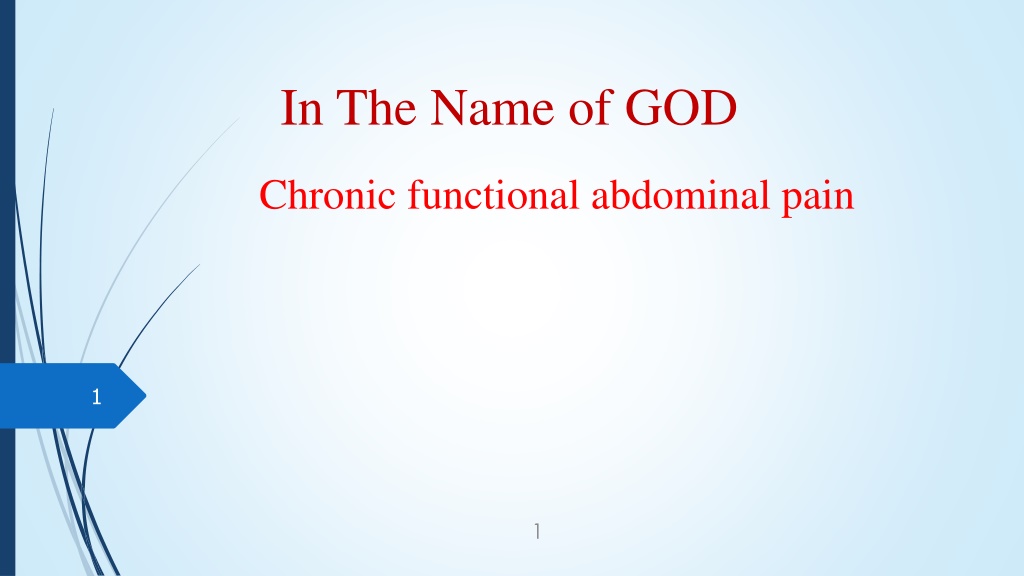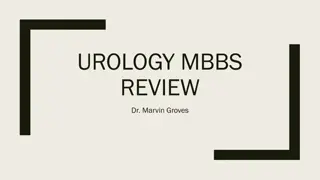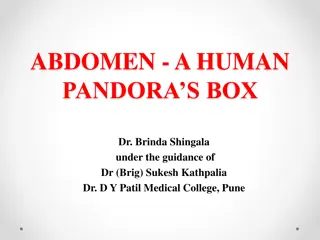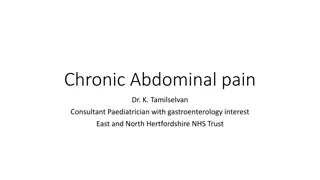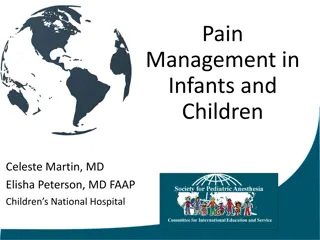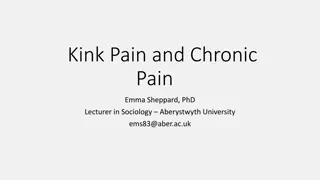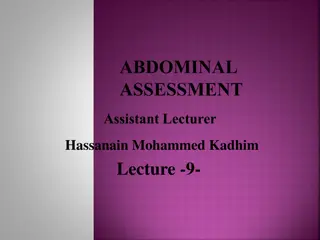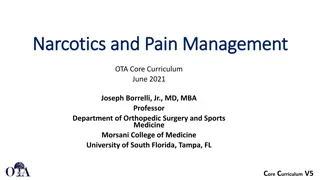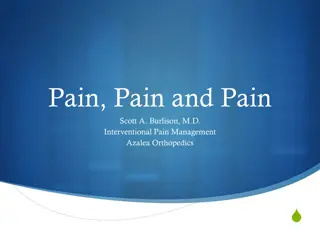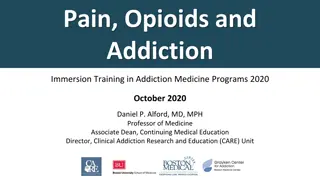Understanding Chronic Functional Abdominal Pain: Clinical Diagnosis and Management
Chronic functional abdominal pain is characterized by persistent discomfort lasting over three months, with various underlying causes such as gastrointestinal disorders, genitourinary issues, and miscellaneous conditions. Diagnosis involves differential assessment and recognizing functional disorders like irritable bowel syndrome and dyspepsia. Effective management requires a comprehensive evaluation and tailored treatment plan to address the specific symptoms and triggers.
Download Presentation

Please find below an Image/Link to download the presentation.
The content on the website is provided AS IS for your information and personal use only. It may not be sold, licensed, or shared on other websites without obtaining consent from the author. Download presentation by click this link. If you encounter any issues during the download, it is possible that the publisher has removed the file from their server.
E N D
Presentation Transcript
In The Name of GOD Chronic functional abdominal pain 1 1
Clinical definition 2 Acute abdominal pain Less than 4 6 week, sub acute (less than 12 week ) single episode, self limited and treatable , episodic localize pain, sharp, stabbing Chronic abdominal pain Pain of at least 3 months duration, long lasting, intermittent or constant that is functional or organic ( disease ) 2
Differential Diagnosis of Chronic or Recurrent Abdominal Pain Functional disorders GI tract Galbladder, Liver, and pancreas Genitourinary tract Miscellaneous causes
Functional disorders Functional abdominal pain Functional abdominal pain syndrome Irritable bowel syndrome Functional dyspepsia Abdominal migraine Aerophagia
GI tract Gastroesophageal reflux disease Helicobacter pylori gastritis Peptic ulcer Esophagitis Lactose intolerance Celiac disease Parasitic infection (Giardia, Ascaris,Tricuris tricura) Inflammatory bowel disease Meckel diverticulum Malrotation with intermittent volvulus Duplication Chronic constipation
Galbladder, Liver, and pancreas Cholelithiasis Choledochal cyst Hepatitis Liver abcess Recurrent pancreatitis Biliary dyskinesia
Genitourinary tract Urinary tract infection Hydronephrosis Urolithiasis Dysmenorrhea Pelvic inflammatory disease
Miscellaneous causes Gilbert s syndrome Familial Mediterranean fever Malignancies Sickle cell crisis Lead poisoning Vasculitis (especially Henoch Soh nlein Purpura) Angioneurotic edema Acute intermittent porphyria
Recurrent abdominal pain 9 Waxes and wanes 3 episodes in 3 months Severe enough to affect daily activities No organic causes Apley and Naish 1958 Terms recurrent and chronic abdominal pain replaced by Pain related functional gastrointestinal disorders . FGID Classified as: Functional dyspepsia ( FD ) Irritable Bowel syndrome ( IBS ) Functional abdominal pain ( FAP ) Abdominal migraine Aerophgia Rome II 1999 Duration of symptoms was changed from 3 months to 2 months Criteria fulfilled at least once a week for at least 2 months before diagnosis Added Functional abdominal pain syndrome Rome III 3
Epidemiology 10 Most common pediatric compliant Prevalence 1 19 % median 8.4% Female have a higher prevalence RAP compared to males Accounting for 2 4% of pediatric office visit peak incidence at 4-6 years and at 7-12 years Higher RAP prevalence: Familial Low socioeconomic , Immigrants 4
functional abdominal pain 11 Recurrent Or continuous Chronic Not well localized Felling of anxiety Distress School absence Wax and wane Characterized chronic abdominal pain Non organic cause Affect daily activities Inter periods of well being 5
Functional dyspepsia 12 Or Recurrent pain persistent At least once / week for at least 2 months before diagnosis Discomfort Centered in the upper abdomen Not associated with the onset of a change in stool frequency or stool form Not relived by defecation Above the umbilicus 6
Irritable bowel syndrome 13 Onset associated with a change in frequency of stool ( >= 4 stools/ day and 2 or less stool per week ) Onset associated with a change in form appearance of stool ( lumpy / hard or loose / watery stool ) Improved by defecation Abnormal stool passage ( straining, urgency or feeling of incomplete evacuation Abdominal discomfort or pain associated with 2 or more of the following at least 25 % of time Irritable bowel syndrome Bloating or feeling of abdominal distention Passage of mucus At least once / week for at least 2 months 7
Intervening periods of usual health lasting weeks to month Paroxysmal episodes of intense acute periumbilical pain that last for 1 hr or more Abdominal migraine 14 Criteria must be included and fulfilled 2 time in the preceding 12 month Interferes with normal activities A family of migraine The Pain associated with two or more of following Abdominal migraine photophobia Anorexia Vomiting Pallor Headache Nausea 8
15 Functional abdominal pain episodic or continuous abdominal pain Insufficient criteria for other FGID At least once per week for at least 2 months before diagnosis FAP 9
Functional abdominal pain syndrome 16 Must include FAP at least 25% of the time and 1 of following Some loss of daily functioning At least once per week for at least 2 months before diagnosis The pain is not feigned (malingering ) Little to no relationship of pain with eating, defecation or menses Somatic symptoms : headache : Limb pain Difficulty sleeping FAPS 10
Aerophagia 17 Abdominal distension Increase progressively during the day Esophageal air sign in chest radiography Visible or audible air swallowing Increase flatus on sleep Aerophagia 11
Pathophysiology of functional abdominal pain Genetic IBS is more common in first degree relative of individual with IBS 18 Disordered Brain Gut communication changes in visceral sensation Visceral hyperalgia Visceral hypersensitivity Intestinal gas and aerophagia: Flatulence Bloating, distension Inflammation Low grade mucosal inflammatory process play a role in IBS Post-infectious IBS Dysmotility Parental factors Most common in families with higher rate of anxiety Serotonin modulating visceral hypersensitivity and motility corticotrophin releasing factor increase in motility and hypersensitivity in IBS Etiology FRAP Stressful event Anxiety Depression 12
How to diagnose FIGD? 19 Taking careful Hx and P/E and recognize red flag: Historical alarm sign Clinical alarm sign Weight loss Significant vomiting Significant diarrhea Gastrointestinal blood loss Unexplained fever Rash Arthritis Delayed puberty Growth retardation Family hx of IBD, celiac disease , PUD Localized tenderness in RUQ Localized tenderness in LLQ Localized fullness Mass effect Hepatomegaly Splenomegaly Oral ulcer Perianal fissure, fistula or tag Occult or gross blood in stool Spine or costovertebral angle tenderness 13
Rome III criteria 20 Essential investigation: according to symptoms e.g CBC UA, Stool Exam Liver, kidney and pancreatic dysfunction Amylase, Lipase Ultrasound Barium Study Gastric Emptying time test, Intestinal transit time, Colon transit time test Hydrogen breath test: Lactose, Lactulose, Glucose, celiac panel Endoscopy Skin prick test Urea Breath test 14
Recommendation of north American Society for Pediatric Gastroenterology, Hepatology and Nutrition 21 Additional diagnostic evaluation is not required in children without alarm symptoms. Testing may be carried out to reassure children and their parents. When history, physical exam, and limited screening tests reveal no abnormalities, the diagnosis of an abdominal pain related functional gastrointestinal disorder can be made. 15
What are the predictive values of diagnostic tests? 22 There is no evidence to suggest that the use of ultrasonographic examination of abdomen and pelvis in the absence of alarm symptoms has a significant yield of organic disease. There is little evidence to suggest that the use of endoscopy and biopsy in the absence of alarm symptoms has a significant yield of organic disease. There is insufficient evidence to suggest that the use of esophageal PH monitoring in the absence of alarm symptoms has a significant yield of organic disease. 16
Pharmacologic treatment approach 25 Treatment Added dietary fiber Definition of disorder RAP Trial Effectiveness A short trial of 2 mo might benefit some children Not recommended Two randomized trial in 2 children 2 randomized trial in 38 children 1 randomized trial in 50 children Small RCT in 25 children Lactose free diet RAP Probiotic LGG IBS Might be helpful in children with IBS Short trial of 4 weeks might to be benefit Not recommended as first line therapy Effective Famotidine RAP with dyspeptic symptoms IBS, abdominal migraine Tricyclic antidepressant 1 RCT in 33children Citaloperam Abdominal migraine Open label trial in 25 children 1 cross controlled trial in 14 children 1 randomized trial of 2 weeks treatment in42 children 2 randomized in 92 children Pizotifen Abdominal migraine Likely to be beneficial Peppermint oil IBS Likely to be beneficial Cognitive behavioral therapy RAP Recommended
Thank for your attention 26 keukenhof flower garden
